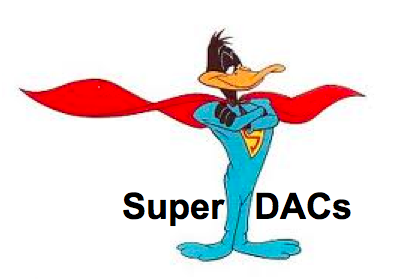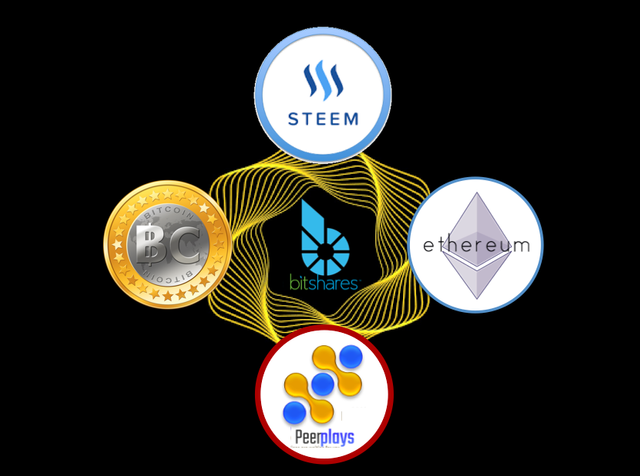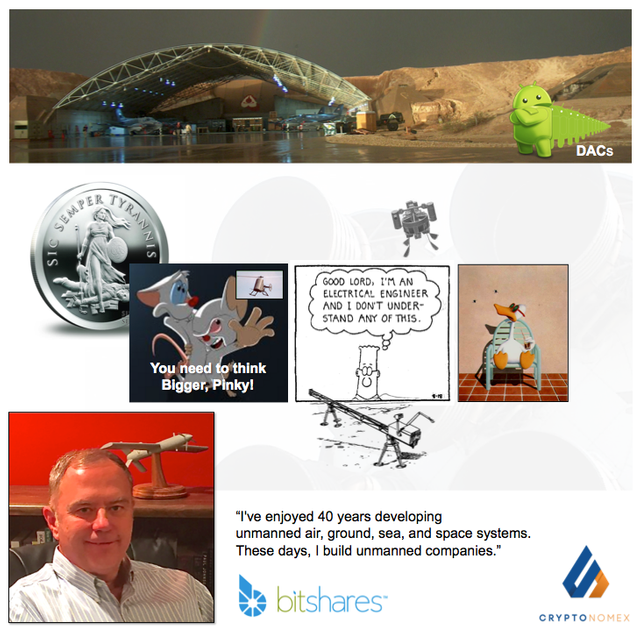Developer Freedom Trumps User Convenience?
Origin of BitShares - Part 16 -
Why BitShares, Steemit, et. al., use separate blockchain platforms
In Part 15 I tried very hard to make the case for why multiple coins, assets, and businesses should be sharing the same blockchain. (The key idea was to reduce economic friction via shared infrastructure.) And yet, every chance we have had to actually spin off a new project, we wound up creating a new platform - precisely the opposite of what I have been recommending! How blatantly inconsistent!
"A foolish consistency is the hobgoblin of little minds,
adored by little statesmen and philosophers and divines." - Ralph Waldo Emerson
We have actually never been accused of being consistent.
A shared public block chain platform dates back to the original SuperDAC! idea from the BitShares merger circa Guy Fawkes Day, 2014.

SuperDAC - noun - soup-er-dak
A Decentralized Autonomous Company (DAC) providing common services that support layering of other DAC business models onto a common public ledger for the sake of shared network effect.
The value of merging our various DACs into a single "SuperDAC" was based on the realization that they all needed a whole bunch of common services that are much less effective if they aren't common services:
- A unified basket of stable, robust global currencies (bitAssets)
- A unified set of well compensated, best-of-breed delegates.
- A unified name system.
- A unified secure messaging system.
- A unified set of on and off ramps - portals to the fiat world.
- A unified marketing message.
- A unified consensus-based governing system.
- A unified family of tools and wallets.
- A unified way for newcomers to make instant friends with everyone already there.
- A built-in venture capital system where you can compete for start-up funds - democratically.
These were the features we built into BitShares fully expecting that they would make it an attractive platform for others to build on instead of "cloning" into separate chains.
Reasons why you still might need a separate platform.
Of course, there are some things that might not go together on the same chain due to differences in rate structure, by-laws, governance or philosophy. We still need diversity! And besides, New York City traders might not feel comfortable on the same platform with a Caribbean gaming business. To each his own.
While it is best to keep assets with compatible business models on the same chain wherever possible, Cryptonomex and its partners have and will release multiple independent chains based on its rapidly advancing technology for these very reasons. Here are the five announced or operational Graphene-based blockchains as of this date.
BitShares upgraded to Graphene technology to provide a real-time decentralized exchange platform supporting a network of traditional exchanges that have agreed to share their order books, products, and services on an open public ledger for improved security, transparency, and combined network effect.
MUSE is a Graphene based platform developed by Cryptonomex for PeerTracks which serves as a real-time platform for every artist, athlete, politician, and other celebrity to issue their own interoperable coins. It needs a different micro-transaction fee structure than a network intended to support high-value financial transactions.
Identabit is a Graphene based platform planned for Identabit.com that emphasizes a unique mix of positive identity, regulatory compliance, government accountability and banking privacy targeting the remittance industry. It can’t co-exist with BitShares’ dogged insistence on anonymous transactions as a philosophical, nay existential, necessity.
Peerplays is the world's first decentralized tournament management and wagering platform built entirely on the blockchain.
Steemit is, of course, the blogging platform that is hosting this article.
The developers for each of these projects chose to go with separate chains, foregoing the benefits of shared infrastructure, for various combinations of the following reasons:
Developer Freedom. When you start a project you never know what changes you may need to make at the platform level. If you have your own platform, you don't need to coordinate with all the other users of the platform. BitShares found out the hard way what happens when you turn governance over to the shareholders before the work is done. Suddenly, everybody wants to run the company and you reach deadlocks that will absolutely kill a startup with a fixed development budget and time to market. Bitcoin, for example, can't even agree on a block size parameter.
Economic Freedom. Face it, everybody needs the freedom to distribute shares in their project wherever they need to gather support and funding. While those shares can technically be distributed much more cost-effectively on an existing platform, there is still the historical perception that they are more valuable as a separate chain. And distribution of shares is always different to account for new investors and contributors. Steemit, for example, needed to distribute its Steem asset to providers of content.
Regulatory Freedom. The more diverse businesses that reside on the same platform the more potential regulations apply. Identabit, for example, wants to require all its user accounts have fully documented identities. This is an anathema to BitShares. Steemit wanted to release its shares based on the latest understanding of what governments are willing to accept, guidance that was not available when BitShares was born.
So, on balance, developer convenience factors that affect how easily startups can get to market have tended to outweigh the largely theoretical value of interacting with other projects at some time in the future. This was a particularly easy decision when everyone realized that side chain technology is on the horizon. Side chains are a way of making multiple blockchains work together like they were a single "braided" chain with many of the common platform benefits we have been advocating. Developers get freedom while users get convenience. The best of both worlds!
But that's a subject for future history.

But, but but...
... what about all that talk in the last post about the foolishness of isolating new businesses on their own "islands" where they can't efficiently share common infrastructure? Are we saying that side chains will act like a network of light speed roads connecting all the islands?
Roads? Nah. Where we're going we won't need roads!

Cheers!
Stan Larimer, President
Cryptonomex
The origin of BitShares and Steemit
Coming up Next: Part 16 - Back to the Future
Previous in the Series:
The Origin of BitShares Rides Again (Parts 1-10)
Part 11 - It Is Very Cold in Space
Part 12 - Never Let Them See You Sweat
Part 13 - Cryptonomex Rears Its Head
Part 14 - The Jump to Light Speed
Part 15 - Blockchain Platform Surfing
About the Author -- Stan Larimer
Follow Me On Steemit - The Social Media Platform That Pays
Please Connect To Me On Linkedin!
Greatest Hits
Bitcoin and the Three Laws of Robotics
Engineering Trust with Charles Hoskinson
The Origin of BitShares
Why I will never give up Christianity

I have been waiting all week for your article. Awesome Stan!
I am myself a firm thinker that a super dac is a good idea, but for some reasons i have a doubt that it will work and maybe its the right idea to seperate things like you guys did.
After all, look what happened to Babylon
Alas, Babylon.
I think it did work. At least that 2014 superDAC thing was bitshares.
Looking forward to the future use of sidechains as being the standard process in blockchain technology. What project wouldn't shine from the power and speed of Graphene?
Thanks @Stan! For me, it was a really interesting read on why separate blockchain / platforms are used :)
Thanks Stan, I always enjoy your history lessons. UPVOTED!
Thank you for a vote. Vote back from me :-)
(I'm reading your article now)
and of course, it's only a matter of time before something gets developed that makes separate blockchains interoperable, whether IPFS or something else...